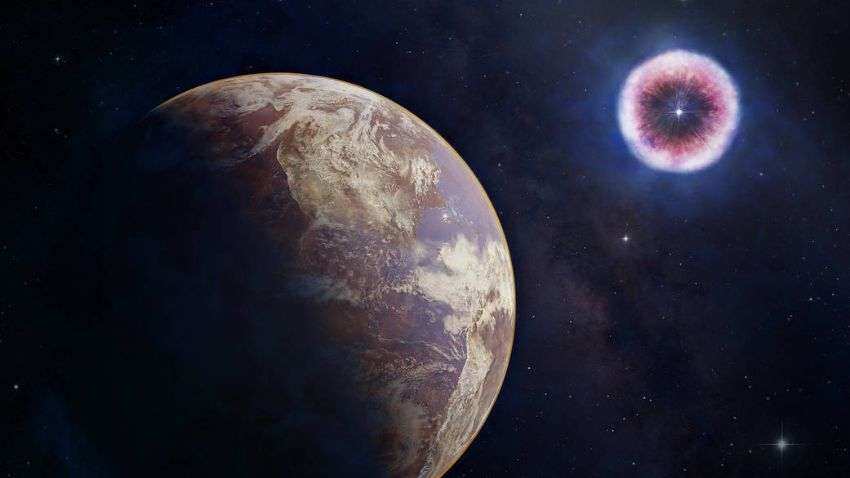NASA scientists identify new stellar danger to planets
NASA Chandra X-ray observatory: Astronomers using data from NASA's Chandra X-ray Observatory and other telescopes have identified a new threat to life on planets like Earth: a period during which intense X-rays from exploded stars can affect planets over 100 light-years away.

NASA Chandra X-ray observatory: Astronomers using data from NASA's Chandra X-ray Observatory and other telescopes have identified a new threat to life on planets like Earth: a period during which intense X-rays from exploded stars can affect planets over 100 light-years away.
The finding, published recently in The Astrophysical Journal, has implication for the study of planets outside the solar system and their habitability.
This threat comes from a supernova's blast wave striking dense gas surrounding the exploded star. When this impact occurs it can produce a large dose of X-rays that reaches an Earth-like planet months to years after the explosion and may last for decades, the researchers said.
Such intense exposure may trigger an extinction event on the planet, they said.
The study is based on X-ray observations of 31 supernovae and their aftermath?mostly from NASA's Chandra X-ray Observatory, Swift and NuSTAR missions, and ESA's XMM-Newton?showing that planets can be subjected to lethal doses of radiation located as much as about 160 light-years away.
If a torrent of X-rays sweeps over a nearby planet, the radiation could severely alter the planet's atmospheric chemistry, the researchers said.
For an Earth-like planet, this process could wipe out a significant portion of ozone, which ultimately protects life from the dangerous ultraviolet radiation of its host star, they said.
It could also lead to the demise of a wide range of organisms, especially marine ones at the foundation of the food chain, leading to an extinction event, according to the study.
After years of lethal X-ray exposure from the supernova's interaction, and the impact of ultraviolet radiation from an Earth-like planet's host star, a large amount of nitrogen dioxide may be produced, causing a brown haze in the atmosphere, the researchers said.
A "de-greening" of land masses could also occur because of damage to plants, they said.
Among the four supernovae, SN 2010jl has produced the most X-rays. The authors estimate it to have delivered a lethal dose of X-rays for Earth-like planets less than about 100 light-years away.
There is strong evidence 'including the detection in different locations around the globe of a radioactive type of iron' that supernovae occurred close to Earth between about 2 million and 8 million years ago.
Researchers estimate these supernovae were between about 65 and 500 light-years away from Earth.
Although the Earth and the solar system are currently in a safe space in terms of potential supernova explosions, many other planets in the Milky Way are not, according to the researchers.
These high-energy events would effectively shrink the areas within the Milky Way galaxy, known as the Galactic Habitable Zone, where conditions would be conducive for life as we know it, they said.
Because the X-ray observations of supernovae are sparse, particularly of the variety that strongly interact with their surroundings, the researchers urge follow-up observations of interacting supernovae for months and years after the explosion.
Catch latest stock market updates here. For all other news related to business, politics, tech, sports and auto, visit Zeebiz.com
Get Latest Business News, Stock Market Updates and Videos; Check your tax outgo through Income Tax Calculator and save money through our Personal Finance coverage. Check Business Breaking News Live on Zee Business Twitter and Facebook. Subscribe on YouTube.
RECOMMENDED STORIES

SBI 444-day FD vs PNB 400-day FD: Here's what general and senior citizens will get in maturity on Rs 3.5 lakh and 7 lakh investments in special FDs?

Small SIP, Big Impact: Rs 1,111 monthly SIP for 40 years, Rs 11,111 for 20 years or Rs 22,222 for 10 years, which do you think works best?

Looking for short term investment ideas? Analysts suggest buying these 2 stocks for potential gain; check targets
03:40 PM IST









 SpaceX secures $843 million NASA contract to de-orbit ISS by 2030
SpaceX secures $843 million NASA contract to de-orbit ISS by 2030 NASA continues to further India-US iCET initiative for "benefit of humanity", says administrator Bill Nelson
NASA continues to further India-US iCET initiative for "benefit of humanity", says administrator Bill Nelson Indian-origin astronaut Sunita Williams set to fly into space for a third time on Tuesday
Indian-origin astronaut Sunita Williams set to fly into space for a third time on Tuesday China set to launch high-stakes mission to moon's 'hidden' side
China set to launch high-stakes mission to moon's 'hidden' side NASA astronauts lose tool bag during first spacewalk
NASA astronauts lose tool bag during first spacewalk